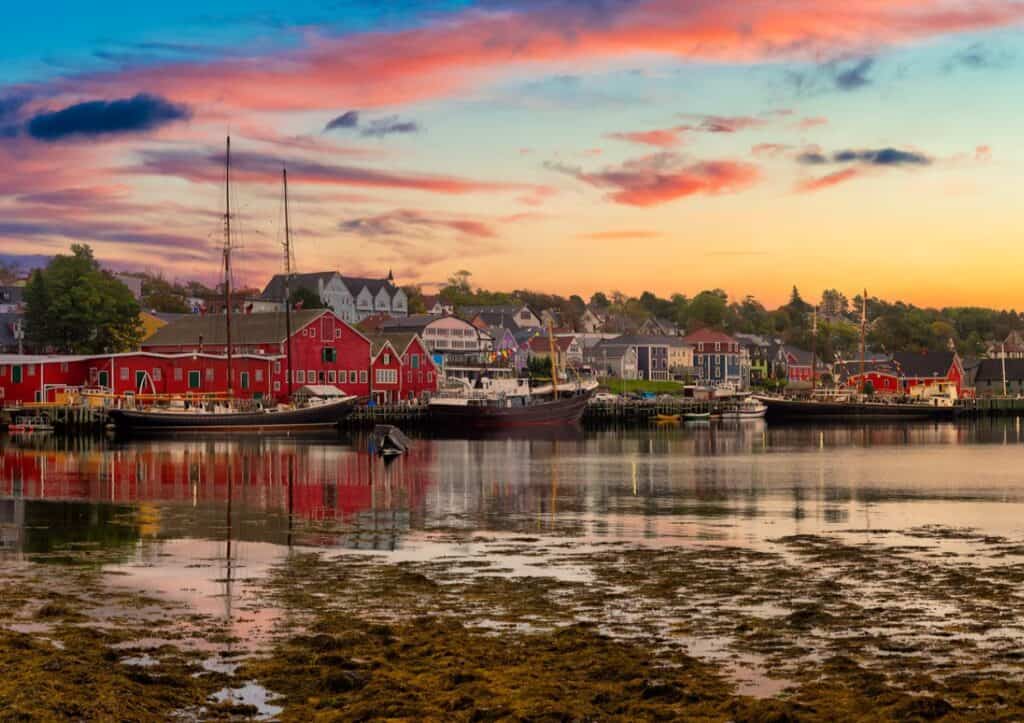Winding along wind-swept coasts, charming wineries and boutique inns, Canada’s continental Maritime provinces offer a lot more than polite residents and lighthouses. Head on a Canadian East Coast road trip and explore all the beauty the region has to offer.

When people think of Canada’s East Coast, their imagination tends to stop at Peggy’s Cove or whale tours. But to do so would be a mistake that could prevent you from experiencing one of the most charming and effortless road trips to navigate across the vast True North.
A road trip across the Canadian East Coast offers travelers a mix of Acadian culture, scenic landscapes and historical sights. This region is a treasure trove of breathtaking vistas and coastal charm. From the rugged beauty of Cape Breton Island’s Cabot Trail to the world’s highest tides in the Bay of Fundy, the East Coast presents an opportunity to explore the natural wonders and diverse heritage that have shaped Canada.
There really is something here for everyone. Families can explore the colorful fishing villages that dot the coastlines, while foodies can savor seafood straight from the Atlantic. Nature enthusiasts can set out on lengthy hikes and culture lovers can immerse themselves in the area’s arts, museums and musical traditions.
The perfect Canadian East Coast road trip will lead visitors through Halifax’s historic waterfront to the UNESCO World Heritage Site of Lunenburg, contrasting with Prince Edward Island’s pastoral landscapes known for their literary connection to “Anne of Green Gables.” Every twist and turn of an East Coast road trip reveals another layer of Canada’s mosaic, inviting roadtrippers to discover the hospitality and enduring allure that the East Coast proudly offers.
Planning your trip

When planning a road trip through the East Coast of Canada, travelers should consider the optimal season for travel, select a route that aligns with their interests, arrange their accommodations or camping well in advance and ensure they pack all essentials for the journey. The good news is we’re here to help you with all of that.
Best time to visit
The ideal time for an East Coast Canada road trip is during the summer months, from June to September when the weather is warm and tourist attractions are fully operational. My family and I went there in April and were disheartened to find many places shut for the season. The ocean winds can also be particularly biting, so warmer weather makes for easier travel.
Route selection
For the best experience, tailor your route to include can’t-miss destinations like the world’s highest tides at the Bay of Fundy and the scenic drives of Nova Scotia’s Cabot Trail. For urban centers, we recommend stopping in Halifax for an all-around experience, Saint John for history and architecture and sleepy Charlottetown for a place to take a break.
Accommodation and camping
Booking accommodations early is recommended. Accommodations range from hotels in major cities to campsites in national parks such as Gros Morne National Park. If you are camping, keep in mind that many places have a two-night minimum.
Packing essentials
Essential items include weather-appropriate clothing, keeping in mind temperatures can fall pretty low at night and that rain is a common sight. As with all road trips, a first aid kit and updated navigation tools are also a must. If you’re a hobbyist photographer, don’t forget to include a camera to capture the breathtaking landscapes you will encounter.
Highlights of the East Coast

The Canadian East Coast is steeped in history and culture. The Maritime provinces are a hodgepodge of architectural styles and historical sites, where both the British and the French laid claims over different parts of the territory. Past wealth can be traced to commerce, forestry and fishing. Though some of the provinces have fallen on harder times, the echoes of past grandeur can still be glimpsed through the grime left by modern oil, pulp and ship manufacturers.
Historic sites and cultural experiences
Travelers can immerse themselves in the region’s past at Halifax’s Citadel Hill and the vibrant atmosphere of the Halifax waterfront. Cultural richness unfolds in the Acadian villages, where you can discover traditional music and stories that have shaped local identities. Wherever you go, make an effort to seek out the histories of the Mi’kmaq, Maliseet, Passamaquoddy, Beothuk and Innu, the First Nations who traditionally made their homes in this region.
Natural wonders and parks
The East Coast features the Bay of Fundy, with the world’s highest tides offering a dramatic seascape. Cape Breton’s Cabot Trail presents a breathtaking journey through the highlands and lush parklands, a serious draw for nature enthusiasts.
Coastal towns
Quaint coastal towns like St. Andrews provide a taste of maritime life and fresh local seafood. Lunenburg in Nova Scotia is a beauty that is not to be missed. Prince Edward Island’s potatoes, mussels and lobster are must-try delicacies, reflecting the region’s deep connection to the sea.
“Driving from Halifax to Sydney takes you through some of the most stunning landscape the country has to offer. As you pass into Cape Breton, you’re surrounded by majestic forests, tall cliffs, and stopping to take pictures of Bras d’Or Lake, a tidal inland lake that opens to the sea, is a must.”
Jenn Allen, All The Best Spots
Transportation options

Efficiently traveling through East Coast Canada requires understanding the various transportation options and being prepared with safety and emergency information. Travelers have multiple modes of transport to choose from. They can rent a car, which provides the flexibility to explore at their own pace. As the roads are pretty easily accessible, any car with sufficient baggage room for your needs will do.
Regional flights are an option for those looking to travel between provinces, especially for reaching more distant areas like Newfoundland. Public transport, though more limited, is available in larger cities like Halifax.
Safety and emergency information
Stay informed about local weather conditions, especially during winter months when roads can be hazardous. In case of emergencies, be aware of the local emergency number, which is 911 across Canada. It’s also wise to keep a list of hospitals and service stations, particularly when exploring remote areas.
Local cuisine

The Canadian East Coast offers a plethora of distinct flavors that are as rich as its cultural heritage. From potatoes to seafood, white fish and cider, there is no shortage of great local produce in the area.
Seafood undoubtedly dominates the local cuisine, with dishes like lobster rolls and Digby scallops being regional favorites. Lobster rolls are a classic, typically served on a toasted bun with a filling of fresh, succulent lobster meat mixed with mayonnaise and celery. Known for their size and sweetness, scallops from Digby, Nova Scotia, are often pan-seared to a golden finish. For dessert, wild blueberry pie, utilizing locally harvested blueberries, is a must-try.
Acadian cuisine is another subsect of the food history here, but you may have to dig deeper to uncover the modest offerings of this lesser-known heritage. Separately, each maritime province offers its own unique and iconic dishes, making food an integral part of the East Coast experience.
Wrapping up
No journey through Canada would be complete without experiencing the unparalleled charm and natural splendor of the East Coast. As you plan your road trip, make time for little stops that let you experience everything, from the musical traditions to the historic sites that echo centuries of heritage.
Seek out the breathtaking coastal vistas, whether it’s witnessing the powerful tides of the Bay of Fundy, the reversing tides in Saint John or traversing the winding paths of the Cabot Trail. Above all, savor the simple pleasures that define maritime life — freshly caught seafood, quaint fishing villages and the warm hospitality of the locals. With an open mind and a sense of adventure, this East Coast road trip promises to be a journey you’ll never forget.
Ksenia Prints is a food writer, blogger, photographer and recipe developer from Montreal, Canada. She blogs over At the Immigrant’s Table, a food blog showcasing healthy, beautiful international recipes for adventurous home cooks. She loves to highlight ethnic cuisines and immigrant cultures by working with chefs from relevant countries and adapting those recipes to gluten-free, vegan, vegetarian, sugar-free and other dietary restrictions.